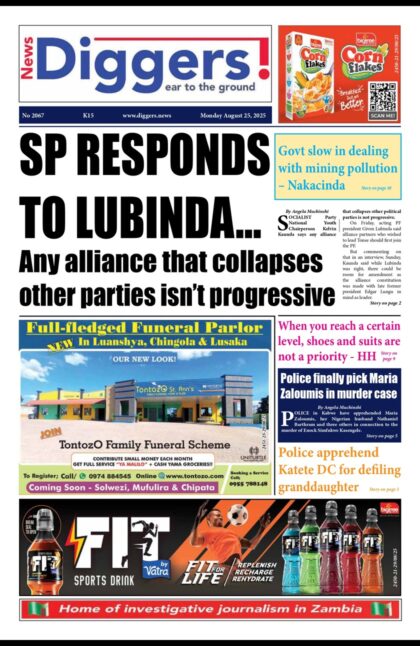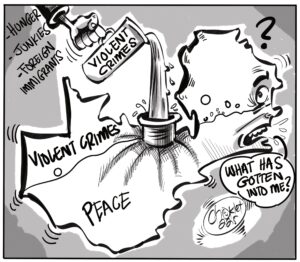Zambia Railways Limited has grown its business by 22 per cent in five months owing to the Statutory Instrument (SI) on heavy cargo, says Transport and Communications Minister Brian Mushimba.
And Mushimba says Zambia Airways will conduct a test flight in October in readiness to officially launch the national carrier to the public.
In January this year, Government, through the Ministry of Transport & Communications, announced the signing of Statutory Instrument (SI) No. 7 of 2018 on rail transportation to compel 30 per cent of bulk and heavy cargo to be transported by rail, making it mandatory for all transporters of bulk and heavy cargo to shift at least 30 per cent of their cargo from road to rail.
Some of the heavy bulk cargo expected to be transported onto railway include: copper and cobalt concentrates, coal, cement, among other heavy goods.
In an interview with News Diggers! in Lusaka, Mushimba disclosed that Zambia Railways had seen its business grow by 22 per cent and that there had been compliance from transporters of cargo since the SI was signed.
“There will be government inspector of railways, there will be Ministry of Transport, there will Zambia Revenue Authority, there will be Weights and Measures Agency. All these will form a task force team of enforcement. Even in the period of these change management, those impacted by this SI have already willingly, have started complying. Zambia Railways has grown their business by 22 per cent ever since we signed the SI to put 30 per cent of heavy cargo on rail. Just within this five-month period. So, people are already complying. There is now a 17 per cent increase in TAZARA and some of it is because of the changes we have implemented,” Mushimba revealed.
He explained that US $120 million, as part of the proceeds arising from the first US $750 million Eurobond issued in 2012, were effectively utilised to revamp Zambia Railways.
“And I want to be very clear of the Eurobond. The US $750 million that was gotten was not for Zambia Railways all of it, and it has been mismanaged, no! Zambia Railways has simply been invested into. The money was for many things and Zambia Railways only got US $120 million. And Zambia Railways has used that US $120 million to remanufacture locomotives, to work on slow-speed areas, to do the signalling, to build the capacity. The speed of Zambia Railways has moved from 10 to 50 kilometres per hour on average. We don’t want to stop there. We want to go to 80 kilometres an hour, to 100 and more, but the point is we have invested enough as government and we feel we have built enough capacity to ask the transportation sector to come back to railway and we are asking for 30 per cent, which we know the capacity is there. And with that 30 per cent, it means extra cargo, on railway,” Mushimba added.
“The real picture around this is that, PF government want to modernise rail transport in our transportation equation, and just like I have been speaking to air transport to make it available for the people; just like I have been speaking to water transportation. The PF government is singularly focused on making sure that all models of transportation are available, accessible and affordable for all the citizens. So, rail transportation had gone to sleep; Zambia Railways had gone to sleep; TAZARA had gone to sleep. There has now been investment in TAZARA, US $70 million as counting, which has reduced the number of slow speed areas by 87 per cent. TAZARA used to take 37 days from Mpika to Dar-es-salaam to transport cargo. It’s taking five to seven days because of investment. Zambia Railways similarly has been invested into.”
He argued that the SI, which was resisted by the mining sector, among other stakeholders, will grow the railway sector even more.
“It means extra business for Zambia Railways and TAZARA, it means extra revenues. It means extra profits, which can now be re-injected back into the rail operations to continue the modernisation agenda and making sure that railway is an option. We gave six month implementation period, which I called the change management. You will have to account for change management. Things don’t just [happen when] you snap a finger and they happen, no! The six months was where TAZARA would engage the transporters of copper cathodes all those would be engaged, and service level agreements would be signed, and other questions would be clarified so that at the end of the six months, we start enforcing. So, we were not enforcing in the six months; it was change management period. So, this six month is ending this month, then enforcement, the enforcement team will be made up of cross-functional team of government officers,” Mushimba narrated.
“The mines were complaining, but they have come on board.”
And Mushimba said Zambia Airways will conduct a test flight in October in readiness to officially launch the airways to the public.
On Sunday, the Industrial Development Corporation (IDC) signed a Memorandum of Understanding (MoU) with Ethiopian Airlines Group chief executive officer Tewolde Gebremariam to mark the two parties’ agreement as shareholders in the venture.
“It’s a lengthy, comprehensive process of giving birth to Zambia Airways. It is a complex undertaking, as a country, we don’t need to be careless by rushing through the process. We have taken our time and it’s coming to the end. It is coming to pass, and the agreements have been signed between Zambia Airways and our strategic partner Ethiopian Airlines. We have the share of the agreement that has been signed. The business model that we want to ride under is that for the first two years, we are going to do domestic flights. Our budget airline is to do local flights to all districts in the country,” said Mushimba, who also revealed during Sunday’s MoU signing that the long-awaited airline will only take off on January 1 next year.
“We want to cultivate a new cadre of air travellers; we want to give access to Zambians to fly. And you know it’s going to be a budget airline where the cost of an airline ticket compared to getting on the bus is comparable. Obviously, people now can see and say, ‘if I top up on my bus fare, I can actually get there on time and quicker.’ Once we have grown that new cadre of air travellers, then we can go regionally and internationally. As soon as we do our test flight around October, sooner after that, you know we should start flying.”























